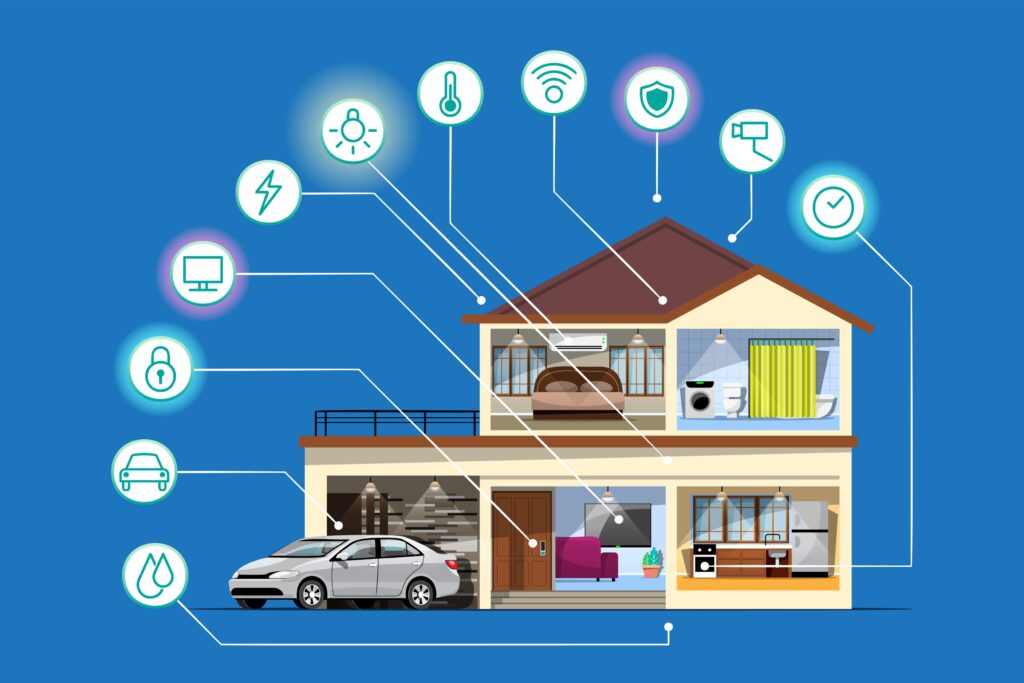Designing a Smart Home Automation System: Advancing Modern Living Through Technological Integration

A connected world has given rise to more intelligent, responsive, and intuitive living environments. This includes a wide range of integrated technologies aimed at easing daily household duties, optimizing energy consumption, and giving new levels of comfort and security. Homeowners may remotely control and monitor many parts of their home areas via a single, centralized platform, redefining ease and empowerment.
These technologies can be adjusted to individual preferences, allowing for a more personalized and adaptive living experience for all family members. Smart home automation is endless, ranging from intelligent lighting and climate control systems to cutting-edge security and entertainment systems. In this blog, we dig into the intricate domain of smart home automation system guidelines, and its important role in molding the future of current life.
Modern Living Advancement Through Technological Integration
To make an informed decision, the following aspects must be considered:
-
Compatibility: Make certain that the system you select is compatible with the devices you already possess or intend to integrate. To avoid compatibility concerns, look for compatibility lists issued by manufacturers or check with an expert.
-
Scalability: Consider your future requirements and select a system that enables easy expansion and integration of additional devices. As technology improves, a scalable system will allow you to adapt and grow your smart home or business.
-
User-friendliness: Choose a system with an intuitive user interface and a simple setup process. A complicated and difficult-to-use system can frustrate users and negate the goal of automation.
How to Select the Appropriate Smart Home Automation System for Your Needs?
-
Seamless integration for business efficiency
The skill of seamless integration is at the heart of any well-designed smart home automation system. These components interact synergistically via centralized control hubs or intelligent controllers, not only for residential comfort but also as a model for commercial efficiency.
-
Controlled by the User for Better Business Operations
In the world of smart home automation, usability is everything. Intuitive interfaces, whether through mobile apps or voice-activated virtual assistants, provide for simple control. Businesses in the smart home market acknowledge the competitive advantage that user-friendly interfaces bring in terms of increasing customer loyalty and retention.
-
Energy Efficiency as a Business Prerequisite
The design of a smart home automation system revolves around energy efficiency. Homeowners and businesses both benefit from energy management through predictive algorithms and intelligent control.
-
Strong Business Security Solutions
Security is a critical factor in smart home automation design, and companies in the industry seek integrated security solutions. Homeowners can enjoy peace of mind and income growth through smart locks, video cameras, motion sensors, and complete security ecosystems.
-
Energy Efficiency as a Business Prerequisite
The design of a smart home automation system revolves around energy efficiency. The capacity to manage energy usage through predictive algorithms and intelligent control is not only beneficial to the environment, but it is also a powerful cost-cutting technique for both homeowners and companies.
-
Strong Business Security Solutions
Security is a critical factor in smart home automation design, and companies in the industry seek integrated security solutions. The use of smart locks, video cameras, motion sensors, and full security ecosystems provides homeowners with peace of mind while also providing chances for income growth in the security business.
How To Build a Smart Home Automation App in your home?
Building a smart home automation app for your home involves several steps that encompass planning, device selection, app development, and integration. Here’s a comprehensive guideline to help you get started:
Planning Your Smart Home Automation App
1. Identify Needs and Goals
Determine what functionalities you want in your smart home app. Consider aspects like security, energy efficiency, convenience, and entertainment.
2. Assess Compatibility
Ensure compatibility between devices and platforms. Check if devices support common protocols like Zigbee, Z-Wave, or Wi-Fi for seamless integration.
Selecting Devices and Infrastructure
3. Choose Smart Devices
Select devices based on your needs (smart lights, thermostats, cameras, locks, etc.). Look for devices that align with your chosen communication protocols.
4. Set Up a Smart Home Hub or Controller
Consider a central hub or controller to manage various devices and protocols. This could be a dedicated hardware device or software-based solution.
Developing the Smart Home Automation App
5. Design User Interface (UI) and User Experience (UX)
Create an intuitive interface for easy navigation and control. Ensure simplicity and accessibility for users of all technical backgrounds.
6. App Development
Choose a platform for development (iOS, Android) and select programming languages and frameworks. Ensure compatibility with various devices and protocols.
7. Integration and Testing
Integrate the app with selected devices and protocols. Test functionalities thoroughly to ensure seamless communication and performance.
Implementing Smart Home Automation
8. Installation and Configuration
Install devices according to manufacturer instructions and configure them to connect to your app and home network.
9. User Training and Support
Educate users on using the app and devices effectively.
Conclusion
Smart home automation system design is a dynamic synthesis of technological capability and business wisdom. Its multidimensional character appeals to a wide range of consumer needs, providing unparalleled opportunities for business growth and profitability. As technology advances, companies in this area will be well-positioned to promote innovation and rethink the essence of modern living.
Smart home automation systems have emerged as a revolutionary force in the quickly evolving IoT ecosystem, altering the way we interact with our living surroundings. The design and implementation of these systems have progressed beyond basic gadgetry to complicated ecosystems that provide a nexus of ease, security, energy efficiency, and unprecedented communication.
Are you ready to live in the future right now? We are one of the best home automation companies in Coimbatore which can assist you in accomplishing this. We are the ideal partner for individuals wishing to enhance their home automation systems because we are committed to innovation and client satisfaction.

